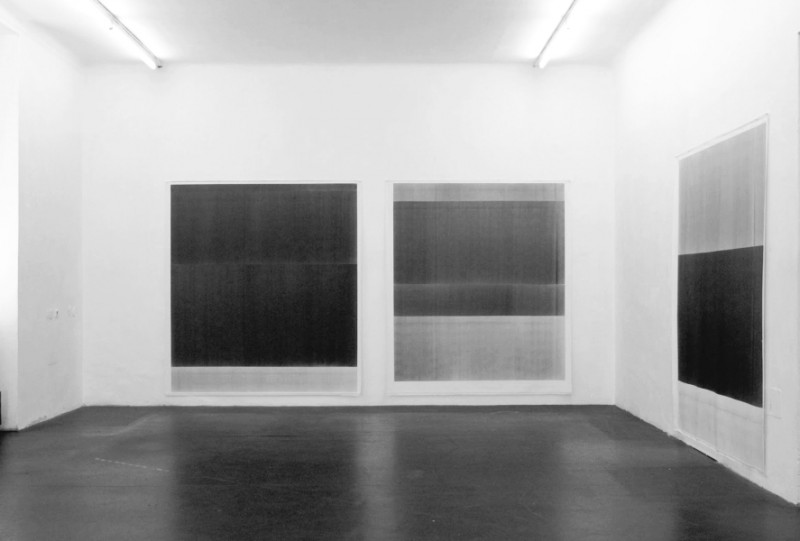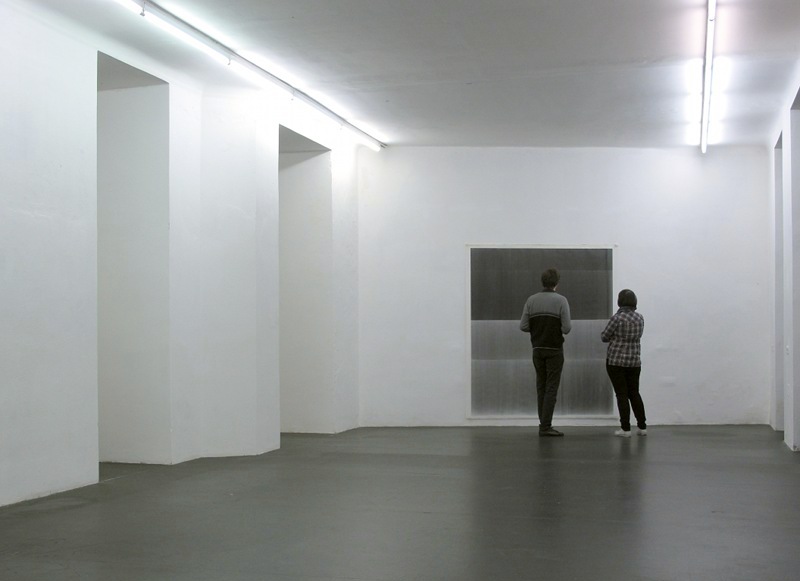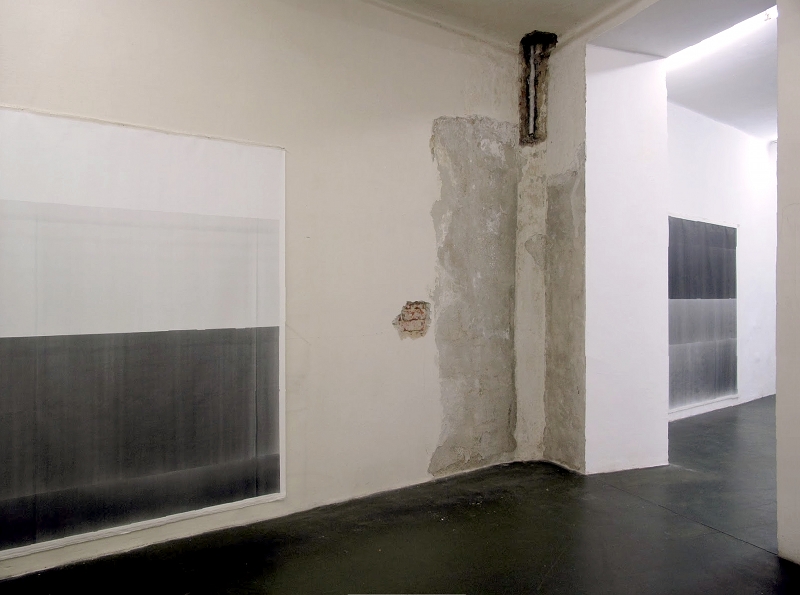Key
2013, LWZ Projekte, Wien



One-day show on 25.10.2013. Project space curated by Gregor Eldarb.
Key Paintings
The current series of works on canvas and paper makes use of a modified painting/printing process in which I aim for reduction, in terms of both the works’ visual form and the technological process. All that is left of a printing process originally developed for industrial use is the cylinder and the printer’s ink. There is no original image to be reproduced. As with works on photographic paper, I merely borrow the methods and materials but leave out the traditional reason for their use – i.e., transferring an image.
Again, the focus is on the importance of the process and the traces that the process leaves behind. The main thing is the material and visual essence of the image object, which shares its creation and history with the viewer. I like to work with tools that have been previously defined. There is no need to paint with a brush, for the ink flows on its own. There is no need to choose a format: photographic paper has a standard series of formats. There is no need to seek out colors, because we have CMYK. Since CMYK are the standard printing tones, I used printer’s ink – for instance, offset (perhaps as a reminder of my school years in a printing office). In the offset printing process the colors are rolled on, and so I use a cylinder. Working with a technique derived in this way from printing technology, I am not interested in reproducibility but rather in the mechanical aspect of the process of creating a picture, in something that forms a kind of counterpoint to certain spiritual connotations of monochrome painting. A layer created in this way is more on the surface, more “in reality”, and less illusory. The colors are mostly used in their pure form, i.e., in the four CMYK tones. Currently, these are primarily black (key) and magenta – sometimes independently, sometimes layered one over the other.
The final character of the print or Xerox also informed the decision not to stretch the canvas. By hanging the paintings loosely, I draw closer attention to the material, which is available by yardage and can be printed from the roll. This movement through a figurative printing press also informs the compositional division into various fields along the entire width. Hanging the work loosely also emphasizes the indefiniteness that is inherent to, for instance, the poster format.
I have here described the formal methods because nothing else can be described. I believe in the image’s direct sensory effect and emotional impact.
J.N., November 2013
Key Paintings
Aktuální cyklus prací na plátně a na papíře využívá modifikovaný malířský/tiskový proces. Tak jako v případě vizuální podoby prací, tak i u technologického procesu jde především o redukci. Z procesu tisku, zdokonaleného pro průmyslové využití, zůstal pouze váleček a tisková barva. Žádná obrazová předloha, která by měla být reprodukována. Podobně jako v případě prací na fotopapíře si vypůjčuji pouze postupy a materiály, ale tradiční důvod pro jejich použití – tedy přenos zobrazení – vynechávám.
Opět jde o důležitost procesu a stop, které proces zanechává. Jde o materiálně vizuální podstatu obrazu-věci, která sdílí svůj vznik, své dějiny s divákem. Rád pracuji s prostředky, které jsou již dány. Netřeba malovat štětcem, protože barva sama teče. Netřeba volit formát – fotopapír má standardní formátovou řadu. Netřeba hledat barvy, protože máme CMYK. Jelikož CMYK jsou standardní tiskové odstíny, použiji tedy tiskové barvy – např.ofsetové (možná jako vzpomínku na učňovská léta). Barvy se v procesu ofsetového tisku navalují, použiji tedy váleček. U techniky takto odvozené z tiskové technologie mi nejde o aspekt reprodukovatelnosti, ta mě nezajímá. Jde spíš o mechanickou složku procesu vytváření obrazu. O něco, co je snad v jakémsi kontrapunktu k jistým duchovním konotacím monochromní malby. Vrstva vytvořená tímto způsobem je více na povrchu, více „v realitě“, méně iluzivní. Barvy jsou většinou použity ve své čisté podobě, tedy ve čtyřech odstínech CMYKu, aktuálně především černá (key) a purpurová (magenta). Někdy samostatně, někdy vrstveny na sebe.
Výslednému charakteru tisku nebo xeroxu je podřízeno i rozhodnutí plátna nenapínat. Volné zavěšení více odkazuje k materiálu, který je k dispozici v metráži, může být potiskován z role. Tento pohyb pomyslným tiskovým strojem nakonec podporuje i kompoziční členění na jednotlivá pole v celé šíři formátu. Volné zavěšení maleb také odkazuje k jisté nedefinitivnosti, která je vlastní např. formě plakátu.
Popisuji formální postupy, protože nic jiného popsat nelze. Věřím na přímé smyslové působení a emocionální dopad obrazu.
J.N., listopad 2013